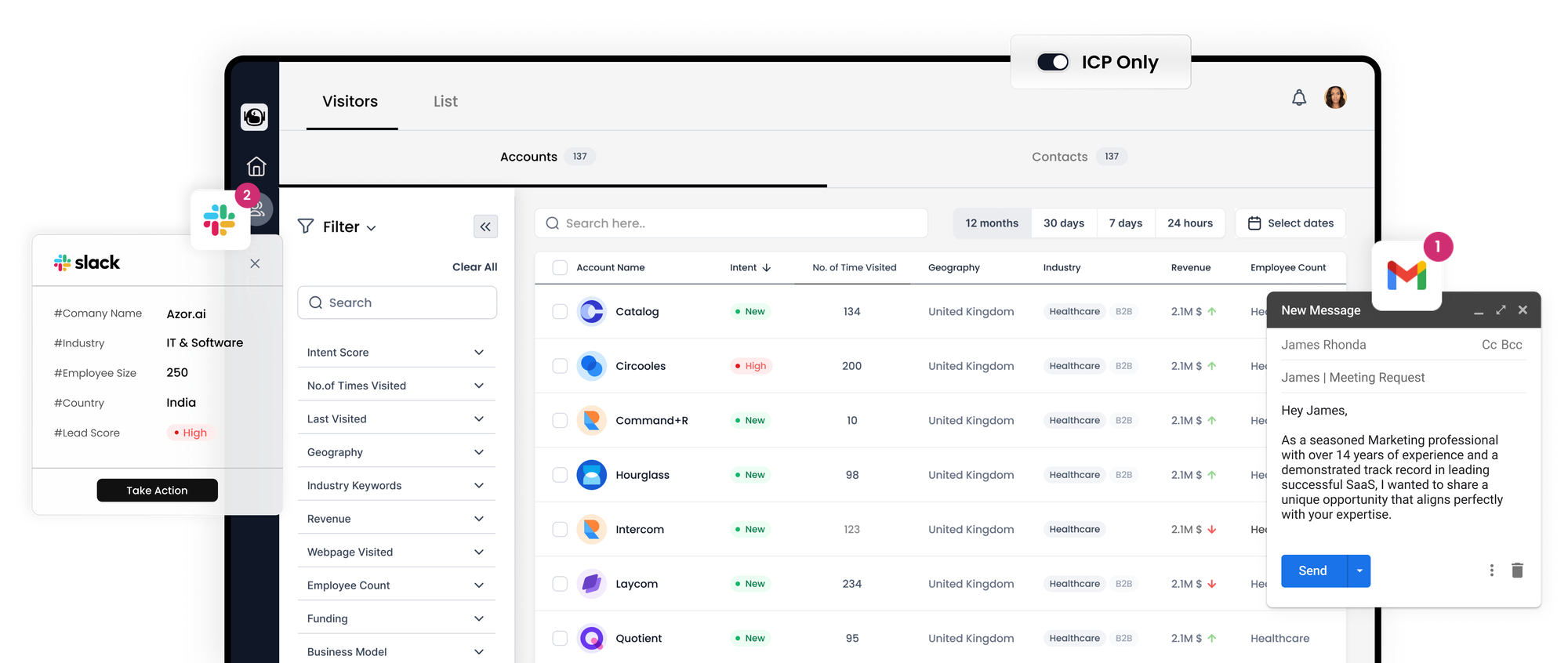Exploring Demand Generation: Definitions and FAQs

Demand generation has emerged as one of the most coveted roles in the realm of B2B marketing, and it's not without good reason. However, a curious issue persists: if you ask various B2B marketers to define demand generation, you'll likely receive a barrage of diverse responses.
Within this comprehensive guide, we aim to provide you with a refined definition of demand generation while delving into the essential components of a successful demand generation strategy.
What Constitutes Demand Generation?
Demand generation encompasses the continuous process of educating individuals who are currently outside your target market – those who aren't actively seeking a solution – about your products and services. Importantly, the objective here is not to overtly sell to them. Demand generation should not be confused with lead generation.

Recapping the Essence of Demand Generation:
1. Long-Term Strategy
Demand generation constitutes a protracted marketing strategy that prioritizes the outreach, education, and engagement of your prospective buyers over time.
2. Versatility
Demand generation initiatives can contribute to competitor targeting, brand awareness building, and the creation of fresh demand by presenting novel solutions to age-old problems.
3. Top-of-Mind Awareness
In the realm of B2B demand generation, the primary goal is to remain memorable. This entails staying at the forefront of potential customers' minds even when they aren't actively considering a purchase.
4. Immediate Recall
The ultimate benefit lies in the fact that when the need for your product or service eventually arises, potential buyers will immediately think of your offering, giving you an edge over competitors.
Key Distinctions: Demand Generation vs. Lead Generation
It's an unfortunate reality that these terms are frequently used interchangeably, despite significant disparities between demand generation and lead generation.
Demand generation marketing centers on educating your audience without any immediate expectation of reciprocation.
On the other hand, lead generation revolves around collecting contact information, a practice that has become somewhat antiquated in today's context, where tools like Cognism are available for purchasing leads.
Lead generation's fundamental flaw lies in its tendency to prematurely funnel disinterested prospects into automated sales workflows – a phenomenon described by Refine Labs as "begging" prospects for meetings.
The Ongoing Demise of MQLs
The concept of Marketing Qualified Leads (MQLs) may still be tracked by some companies, but it is fundamentally outdated and out of touch with modern marketing dynamics. Several reasons necessitate the abandonment of MQLs:
1. Distant from Business Opportunities
MQLs are distantly removed from actual business opportunities, leading to a distorted view of marketing effectiveness.
2. Funnel Overcrowding
MQLs contribute to funnel bloat and an unrealistic perception of marketing efficiency.
3. Inefficient Sourcing
They often originate from inefficient sources, such as lead list uploads, where most individuals have not engaged meaningfully with your brand.
4. Inadequate Indicator
MQLs inadequately signify downstream funnel performance, leading to wasted resources in marketing operations.
5. Resource Drain
Managing MQL nurturing requires considerable human effort for creating flows, composing email copy, segmenting data, and reporting on system performance, which is an inefficient allocation of resources dedicated to the top of the funnel.
In essence, the pursuit of MQLs through automated email nurturing and other outdated tactics doesn't align with the way modern B2B buyers make decisions. The practice of stretching and reaching based on implied intent actions diverges from contemporary best practices in B2B marketing.
The Detriments of Lead Generation Strategies
1. Misalignment with the Buyer's Journey
A significant drawback of many lead generation efforts is their misalignment with the buyer's journey. Surprisingly, B2B buyers spend only 17% of their time engaging with sales representatives. Yet, most lead generation strategies prioritize ushering prospects into premature sales conversations.
2. Adverse Impact on Sales Teams
The concept of Marketing Qualified Leads (MQLs) is problematic because, by definition, MQLs are not in a buying cycle. Consequently, subjecting Sales Development Representatives (SDRs) to a deluge of disinterested prospects can seriously dent their morale.
3. Strained Relationship between Sales & Marketing
Lead generation practices often give rise to a strained dynamic between sales and marketing teams. Discontent surfaces in the form of conversations like "marketing is sending us low-quality leads" and "sales can't close deals," fostering a negative team culture.
4. Gated Content Generates Top-of-Funnel Leads
Common types of content such as white papers, webinars, case studies, and free tools primarily capture the contact information of uninterested buyers, contributing to inefficiencies in the lead generation process.
5. Over-Reliance on Lead Scoring and Nurturing
Many lead generation strategies rely excessively on lead scoring and nurturing, hinging on implied intent. This approach places a significant bet on the marketing team's ability to leverage behavioral data and intent signals to predict sales triggers.
Essentials of a Demand Generation Strategy
1. Establish Robust Brand Awareness:
- Immerse Yourself in Buyer Personas: Delve deeply into the world of your buyer personas, following frameworks like "Easy Mode" by Obaid Durrani and Todd Clouser.
- Pursue Thought Leadership on Offsite Channels: Recognize that most individuals no longer educate themselves solely on corporate websites; hence, engage in thought leadership beyond your own platform.
- Leverage Social Media Platforms: Engage with B2B buyers on platforms like LinkedIn, where they seek peer advice on solving challenges.
- Implement a Branded Search Strategy: Focus on branded SEO, gauging success by the frequency of people searching for your brand in conjunction with your product or service name.
- Optimize B2B Advertising for Awareness: When utilizing advertising, employ calls to action like "Learn More" instead of "Get a Demo."
2. Fine-Tune Your Inbound Marketing Funnel:
- SEO: Create content that addresses specific, pain-point-focused topics rather than broad-reaching subjects.
- Paid Advertising: Capture existing demand with paid search and affiliate marketing, while simultaneously generating demand through social media platforms like LinkedIn, Twitter, Facebook, Reddit, and more.
- Sponsorship Marketing: Reach potential buyers by collaborating with content creators, as people often subscribe to their favorite content rather than corporate newsletters or podcasts.
- Email Marketing: Develop an email marketing strategy for B2B workflows that aligns with best practices, focusing on audience engagement rather than lead nurturing.
3. Empower Your Sales Teams:
- Utilize Testimonials: Displaying testimonials, akin to Chili Piper's "wall of love," can significantly boost credibility.
- Create Compelling Case Studies: Present case studies that outline problems, use cases, solutions, and outcomes, such as the example of "Why Refine Labs Chose Chili Piper."
- Implement Content Systems: Employ content management systems that assist sales teams in efficiently accessing and utilizing essential collateral.
- Develop Battle Cards: Equip sales teams with valuable insights about competitors through battle cards.
- Provide Sales Training: Consider options like virtual sales coaching to help sellers enhance their skills, as time constraints often hinder traditional training approaches.
The Role of Inbound Marketing in B2B Demand Generation
The conventional SaaS marketing funnel has become outdated.
In today's landscape, you are either capturing existing demand or actively creating new demand.
Let's delve into what this entails.
Demand Capturing: Intent Channels and Examples of Content
Examples of Demand Capture — Exploring Alternatives to Calendly, Identifying the Best Snowflake ETL Tools, A Guide to Blocking Websites on Android Devices, Selecting a Compliance Training Platform, and more.
Verticalized Demand Capture — Focusing on niche areas such as SEO for Startups, ERP Integration Solutions for Distributors, Evaluating Alternatives to Happeo Intranet, and SMB Backup Options for Cloud and On-Premise.
SEO – A bottom-of-funnel demand generation strategy, involving content marketing that encompasses blog posts and landing pages optimized for keywords indicating purchase intent.
PPC – Engaging in paid advertising campaigns by bidding on transactional keywords to reach your target audience at the stage when they are narrowing down potential solutions.
CRO – Embracing conversion rate optimization practices, where marketers conduct testing programs to enhance conversion rates for website traffic displaying high purchase intent.
Review Websites – Leveraging platforms like G2, TrustRadius, and Gartner, where your buyer personas seek detailed peer reviews and ratings for your brand, products, and services.
Demand Creation: Education Channels and Types of Content
Utilizing Social Media Platforms: Engaging with your audience on platforms such as LinkedIn, Twitter, Facebook, and TikTok.
Leveraging Influencer Marketing: Collaborating with relevant influencers within your niche for brand awareness or demand generation campaigns.
Harnessing the Power of Email Marketing: Employing strategies like newsletters, content promotions, nurture sequences, and event invitations.
Engaging with Online Communities: Participating in forums like Exit Five and Sales Hacker to connect with your target audience.
Exploring Offline Media: Utilizing traditional methods like direct mail and advertising in locations such as the NYC subway.
Leveraging Offsite Channels: Contributing guest posts, press releases, and thought leadership content to external platforms.
Embracing Audio Channels: Utilizing podcasts, interviews, and radio advertising to reach your audience.
Creating Video Content: Sharing videos on platforms like YouTube, LinkedIn, Vimeo, Wistia, and Loom to engage and educate.
Hosting Events: Organizing webinars, live hangouts, virtual conferences, as well as participating in in-person meetups and industry trade shows.
Engaging in Forums: Actively participating in online forums like Reddit, Quora, Slack, and Discord to connect with potential customers and provide valuable insights.
The Role of Sales in B2B Demand Generation
If we rewind the clock seven years, many would have described demand generation as merely marketers attempting to mimic salespeople by employing lead generation tactics.
This perception persisted because marketing traditionally played a subservient role to sales. However, a transformation occurred when B2B executives recognized that marketing should be a strategic partner rather than just an order-taker.
In today's landscape, outbound-focused demand generation has evolved beyond high-volume cold outreach and automated follow-up sequences. It has embraced the concept of ABM (account-based marketing) and adopted an inverted marketing funnel approach.
ABM represents a bottom-up marketing strategy that collaborates closely with sales teams to engage with high-quality leads and target specific accounts, particularly during complex B2B sales cycles. Revenue teams have recognized that a hybrid approach, incorporating inbound, outbound, and lifecycle automation, strikes the right balance for a high-performing demand generation program.
Metrics & KPIs for Measuring Success
Your efforts in demand generation marketing should be anchored by a central metric: lead quality. In addition to grasping essential SaaS metrics, consider these crucial questions:
1. Which channels are delivering highly qualified leads?
2. What is the conversion rate from opportunities to paying customers?
3. What proportion of paying customers demonstrates long-term profitability?
4. Which marketing channels yield opportunities with the highest customer lifetime value (LTV)?
5. How can we enhance the speed at which we respond to leads?
Leading Indicators: Example Metrics
- Brand search volume
- Comparison between your brand and competitor brand search volume
- Organic traffic directed to high-intent website pages
- Direct traffic (individuals directly entering your website URL into their browser)
- Entrances and engagement on feature/solutions pages
- Referral traffic originating from relevant websites and social platforms
Lagging Indicators: Example Metrics
- Assisted conversions: Pages visited along the path to a conversion
- Website traffic-to-conversion rate (indicating declared intent)
- Conversion rate from qualified demo to sales opportunity
- Proposal sent to closed/won rate
- Average deal size categorized by source
- Cost per acquisition (CPA)
- Customer lifetime value (CLV)
Declared Intent vs. Assumed Intent – A Fundamental Distinction
The landscape of digital marketing has shifted from the traditional direct response and lead generation-focused campaigns to embrace a more comprehensive demand generation approach. This approach encompasses various aspects, including brand awareness, demand creation, and demand capturing across the entirety of the sales funnel.
In the realm of B2B marketing, it is imperative to delve into the realm of website call-to-action (CTA) buttons and distinguish between declared intent and assumed intent.
Conducting a "declared intent audit" becomes a pivotal step to ascertain whether leads with assumed intent are being treated as if they possess declared intent. If such a misalignment exists, it signifies a disconnect between the sales experience provided and the expectations of the prospective buyers.
This audit serves as the litmus test, validating whether your marketing team comprehends the intricate nuances of the customer journey, an indispensable element of any effective demand generation program.
